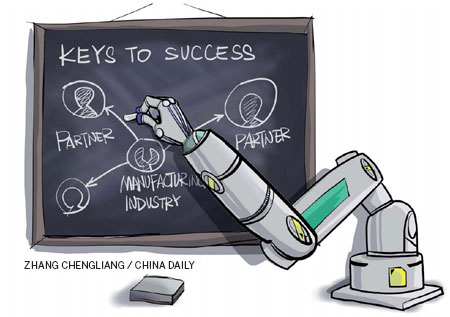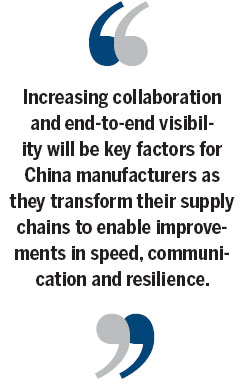Collaboration key to progress
Updated: 2013-08-30 09:59
By Peter J Liddell (China Daily)
|
|||||||||||


Better coordinations can help companies build successful supply chain partnerships in China
Manufacturers in China continue to be challenged by intense global competition and the rise of key input costs. Yet, while growth in the rest of the world tapers off, China continues to be a magnet for global manufacturing companies.
There are emerging opportunities for manufacturers in China to capitalize on future growth, where deliberate policy decisions will propel an economy with a focus on accelerating local consumption. To capitalize on the expected demand-driven economic growth, China-based manufacturers must ensure that their supply chain strategies stay ahead of the pack.
In a recent global manufacturing survey undertaken by KPMG in partnership with the Economist Intelligence Unit, one of the key findings highlights that manufacturers are viewing their channel partners as more of a "network" that is critical to achieve a "demand-driven" supply chain - one that provides a real-time view to total demand, supply, and capacity information.
For manufacturers of all sizes, genuinely closer working relationships between suppliers and other partners will be critical to maximizing their responsiveness to changes in a dynamic market such as China. More effective collaboration with channel partners will enable manufacturers to meet the constant changes in customer demand whilst better optimizing inventory, logistics and other operational costs.
The survey results seem more relevant than before in China where manufacturers face unique supply chain challenges. To survive, China-based manufacturers need to rely on their network of partners to help navigate these local challenges, such as transport impediments due to customs clearance delays and infrastructure limitations, as well as insufficient logistics capabilities and a lack of high-quality supply chain services.
The manufacturers also need to maintain close working relationships across their supply chain by understanding the motivations of their trading partners and determining how best to work with them to ensure that they are not reprioritized by their distribution partners.
The next wave of supply chain gains is expected to be dramatic, as a new spirit of partnership, transparency and visibility across the value chain create enormous economic value from a technology-enabled demand-driven supply chain. The financial benefits achieved by Chinese supply chain networks that have recently optimized and working better with their partners are significant. Manufacturers with mature and well-structured supply chains have realized an additional 3 to 6 percent reduction to their total supply chain operating cost base (which falls straight through to the bottom line) once they have mastered network partnering and collaboration. The more agile and flexible they become, the more strategic the advantage they exercise over the competitors and the greater financial returns that are generated. The opportunity for those manufacturers with less mature and not so well-structured supply chains is even more significant.
The report, "2013 Global Manufacturing Outlook, Competitive advantage: enhancing supply chain networks for efficiency and innovation", notes that companies remain well aware of the importance of investing in R&D, and that increasingly, manufacturers are finding that their supply chain partners can play a critical role in their innovation strategies provided that they can overcome a series of challenges in deepening collaboration with outside partners. One of the top five innovation challenges highlighted by the survey is the complexity in collaborating with suppliers and partners. This finding is very relevant in China where data availability and access to quality decision-support technologies are not as accessible as in other mature markets. These challenges reduce the ability of China-based manufacturers to collaborate across their supply chains.

Interestingly, the survey also identified that, "visibility is the new watchword in supply chain optimization and it is a major opportunity for many companies. Many companies have a substantial opportunity to boost performance, agility, and resilience by improving visibility across their supply chain network."
Yet the survey outlined that nearly half of the respondents state that they lack visibility beyond their tier-one partners. In China, it is extremely important for manufacturers to work with all trading partners throughout the extended supply chain, especially as China continues to experience a high occurrence of critical supply chain disruptions such as transport delays, and product recalls. Harnessing emerging technologies that provide easy access to high-quality information to support end-to-end supply chain visibility will allow manufacturers in China to make timely decisions and become more responsive to unplanned events and challenges.
The survey also highlighted that only 9 percent of respondents can assess the impact of supply chain disruption in a matter of hours. With frequent supply chain disruptions occurring in China, the impact on local manufacturers is inflated and puts them at a distinct disadvantage to their global competitors. The survey also highlighted that the larger (greater than $5 billion or 3.7 billion euros) companies are likely to be better equipped to analyze and deal with unforeseen events, yet only 20 percent of large manufacturers said that they were capable of assessing the impact in a matter of hours, implying that 80 percent still have room for improvement.
Many manufacturers in China are working with professional consultants to invest in a variety of new techniques and technologies to enhance their supply chain capabilities as they aspire to realize true demand-driven planning capabilities, as a means to become more efficient and effectively respond to changes with supply, capacity and demand. However, they must also attain a complete end-to-end picture of their supply chain trading partners' performance. In China, the two key factors that limit the achievement of this continue to be a lack of partner collaboration and poor supply chain visibility.
Increasing collaboration and end-to-end visibility will be key factors for China manufacturers as they transform their supply chains to enable improvements in speed, communication and resilience. Greater responsiveness to tomorrow's changes relies on collaborative partners, yet the survey highlights that 47 percent of respondents are struggling to align operations to real-time fluctuations in customer demand, and 49 percent are only familiar with their tier-one suppliers, supply chains.
Adopting a demand-driven supply chain model supported by multi-tier visibility and collaborative partnerships throughout the supply chain is a journey, something that will evolve over time. While there is no short-term fix, those China-based manufacturers that move first toward better collaboration and true partnering within their supply chain network will ultimately gain a significant competitive advantage.
The author is a partner with KPMG China. The views do not necessarily reflect those of China Daily.
( China Daily European Weekly 08/30/2013 page11)
Today's Top News
List of approved GM food clarified
ID checks for express deliveries in Guangdong
Govt to expand elderly care
University asks freshmen to sign suicide disclaimer
Tibet gears up for new climbing season
Media asked to promote Sino-Indian ties
Shots fired at Washington Navy Yard
Minimum growth rate set at 7%
Hot Topics
Lunar probe , China growth forecasts, Emission rules get tougher, China seen through 'colored lens', International board,
Editor's Picks

|

|

|

|

|

|





